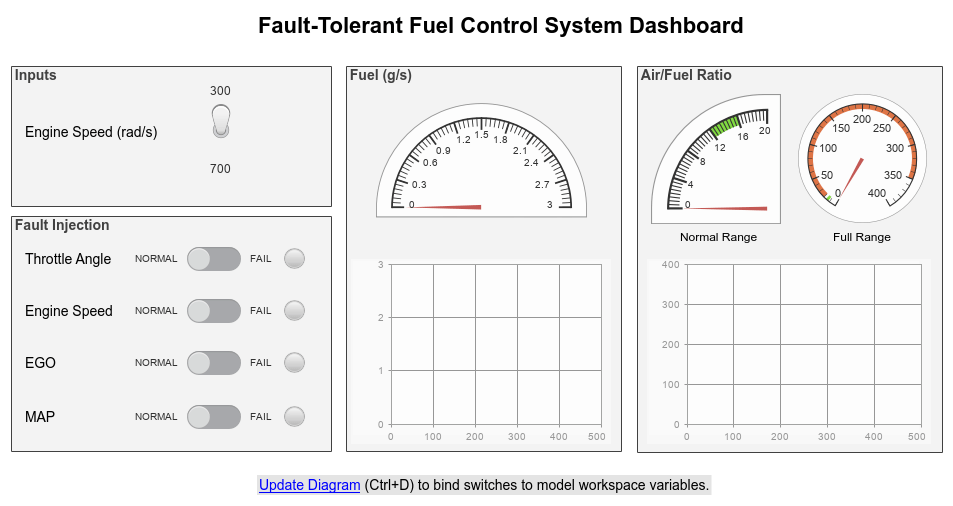Toggle Switch
Toggle parameter between two values
Libraries:
Simulink /
Dashboard
Description
The Toggle Switch block toggles the value of the connected block parameter between two values during simulation. For example, you can connect the Toggle Switch block to a Switch block in your model and change its state during simulation. Use the Toggle Switch block with other Dashboard blocks to create an interactive dashboard for your model.
Double-clicking the Toggle Switch block does not open its dialog box during simulation and when the block is selected. To edit the block's parameters, you can use the Property Inspector, or you can right-click the block and select Block Parameters from the context menu.
Connect Dashboard Blocks
Dashboard blocks do not use ports to connect to model elements. To connect dashboard blocks to variables and block parameters, use connect mode. Connect mode facilitates the process of connecting dashboard blocks in your model, especially when you want to connect multiple blocks at once. To connect a single dashboard block, you can also use the Connection table in the block dialog box.
Tip
You can modify dashboard block connections in your model during normal and accelerator mode simulations.
Note
Dashboard blocks cannot connect to variables until you update the model diagram. To connect dashboard blocks to variables or modify variable values between opening your model and running a simulation, update the model diagram using Ctrl+D.
To enter connect mode, in the canvas, select the dashboard block to connect. On the Simulink® Toolstrip, a tab named after the type of the selected block appears. On the block tab, click Connect. In connect mode, when you select one or more blocks, a list of parameters and variables available for connection appears. Select a variable or parameter from the list to connect to the selected dashboard block.
When the value of the selected variable or block parameter is nonscalar, use the text box
at the bottom of the Connection table to specify the element you want
to connect to the dashboard block. To connect to an element of a vector, matrix, or array,
specify the element index, for example, 3 or (1,3). To
connect to an element in a bus or structure, specify the element in the context of the bus
or structure hierarchy by using dots to indicate different levels in the hierarchy, and omit
the top level. For example, specify a.b to connect to scalar element
b of the structure or bus a nested inside the
selected composite variable or parameter.
To connect another dashboard block, pause on another dashboard block and click the Connect button above it. Then, make a selection of signals and blocks in your model and choose a model element to connect.

When you finish connecting the dashboard blocks in your model, on the block tab, click Done Connecting.
Tip
You can hide the message shown on unconnected blocks using the
set_param function with the ShowInitialText
block parameter. The message also disappears when you connect the block.
Parameter Logging
Tunable parameters connected to dashboard blocks are logged to the Simulation Data
Inspector, where you can view the parameter values along with logged signal data. You can
access logged parameter data in the MATLAB® workspace by exporting the parameter data from the Simulation Data Inspector
by using the UI or the Simulink.sdi.exportRun function. For more information about exporting
data using the Simulation Data Inspector UI, see Export Data to Workspace or File. The
parameter data is stored in a Simulink.SimulationData.Parameter object, accessible as an element in the
exported Simulink.SimulationData.Dataset.
Limitations
Except for the Dashboard Scope block and the Display block, dashboard blocks can only connect to real scalar signals.
The toolstrip does not support blocks that are inside a panel.
You cannot use the Connection table in the block dialog to connect a dashboard block to a block that is commented out. When you connect a dashboard block to a commented block using connect mode, the dashboard block does not display the connected value until the you uncomment the block.
Dashboard blocks cannot connect to model elements inside referenced models.
When you simulate a model hierarchy, dashboard blocks inside referenced models do not update.
Dashboard blocks do not support rapid accelerator simulation.
When you connect a dashboard block to a variable or parameter during simulation, the data for that variable or parameter is not logged to the Simulation Data Inspector. To log variable and parameter data to the Simulation Data Inspector, connect the dashboard block to the variable or parameter prior to simulation.
When you simulate a model in external mode with the Default parameter behavior set to Inlined, dashboard blocks can appear to change parameter and variable values. However, the change does not propagate to the simulation. For example, Gain blocks display changes made to the Gain parameter using the dashboard blocks, but the Gain value used in the simulation does not change.
Parameters
Block Characteristics
Data Types |
|
Direct Feedthrough |
|
Multidimensional Signals |
|
Variable-Size Signals |
|
Zero-Crossing Detection |
|

